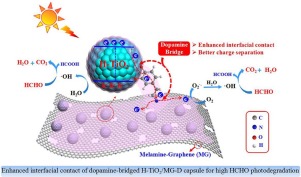Applied Catalysis B: Environment and Energy ( IF 22.1 ) Pub Date : 2018-03-20 , DOI: 10.1016/j.apcatb.2018.03.061 Meiping Zhu , Yaseen Muhammad , Peng Hu , Bingfeng Wang , Yang Wu , Xiaodan Sun , Zhangfa Tong , Zhenxia Zhao

|
A novel synergistic strategy of N-doping and N-wrapping/bridging to synthesize photosensitive and conductive Graphene-TiO2 composite nano-capsules for gaseous HCHO degradation was proposed. High HCHO photodegradation activity of the composite was attributed to the enhanced interfacial contact of TiO2 with conductive melamine-doped graphene (MG) sheets by dopamine (DA) bridging. MG improved the electrical conductivity and photoinduced charges separation/transfer in the MG/TiO2 composite. Moreover, hydrogen treated DA wrapped/bridged MG/TiO2 composite (H-TiO2@MG-D) forming a 3D nano-capsule structure, which could concomitantly strengthen the interfacial contact between TiO2 and MG sheets and accelerates electron mobility. Characterization and DFT simulation results revealed that H-TiO2@MG-D nano-capsules exhibited the lowest band gap (2.49 eV) and highest charges separation efficiency. Simulation results further indicated that N-doping accelerated the transfer of adsorption sites from acidic Ti4+ (for HCHO) to basic N sites (for HCOOH and CO2) before and after HCHO degradation reaction. The enhanced interfacial contact of H-TiO2@MG-D resulted in its remarkably higher HCHO photocatalytic degradation efficiency (ŋ = 92%) and fast degradation rate (k = 15.04 × 10−3 min-1) than that of pristine TiO2 by a factor of 4.1 and 9.2, respectively. Therefore, the present study attributed to ease of synthesis and novel N-doping and N-wrapping strategy for the preparation of highly conductive MG-TiO2 composite can be deemed as an effective and promising pathway for HCHO photodegradation and other similar photocatalytic applications.
中文翻译:

多巴胺桥接的三聚氰胺-石墨烯/ TiO 2纳米胶囊的界面增强接触,可有效地光催化降解气态甲醛
提出了一种新型的N掺杂和N包裹/桥接的协同策略,以合成光气和导电的石墨烯-TiO 2复合纳米胶囊用于气态HCHO的降解。复合材料的高HCHO光降解活性归因于TiO 2通过多巴胺(DA)桥接增强了与导电三聚氰胺掺杂的石墨烯(MG)片材的界面接触。MG改善了MG / TiO 2复合材料的电导率和光诱导电荷的分离/转移。此外,氢处理的DA包裹/桥接的MG / TiO 2复合材料(H-TiO 2 @ MG-D)形成3D纳米胶囊结构,可以同时增强TiO 2之间的界面接触。和MG形成薄片并加速电子迁移率。表征和DFT模拟结果表明,H-TiO 2 @ MG-D纳米胶囊具有最低的带隙(2.49 eV)和最高的电荷分离效率。模拟结果进一步表明,在HCHO降解反应之前和之后,N掺杂加速了吸附位从酸性Ti 4+(对于HCHO)向碱性N位(对于HCOOH和CO 2)的转移。H-TiO 2 @ MG-D的界面接触增强,其HCHO光催化降解效率(ŋ = 92%)和快速降解速率(k = 15.04×10 -3 min -1)比原始TiO高。2分别是4.1和9.2的因数。因此,本研究归因于易于合成以及制备高导电性MG-TiO 2复合材料的新颖的N掺杂和N包裹策略,可以被认为是HCHO光降解和其他类似光催化应用的有效途径。


























 京公网安备 11010802027423号
京公网安备 11010802027423号